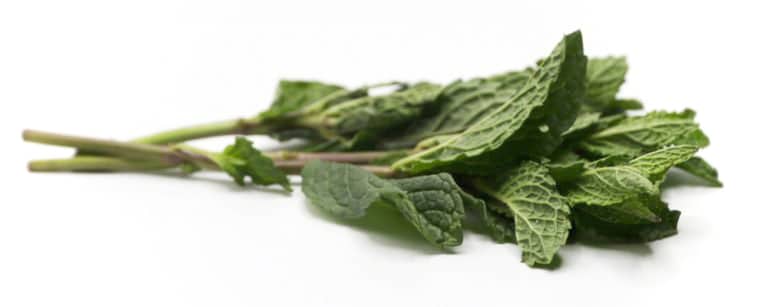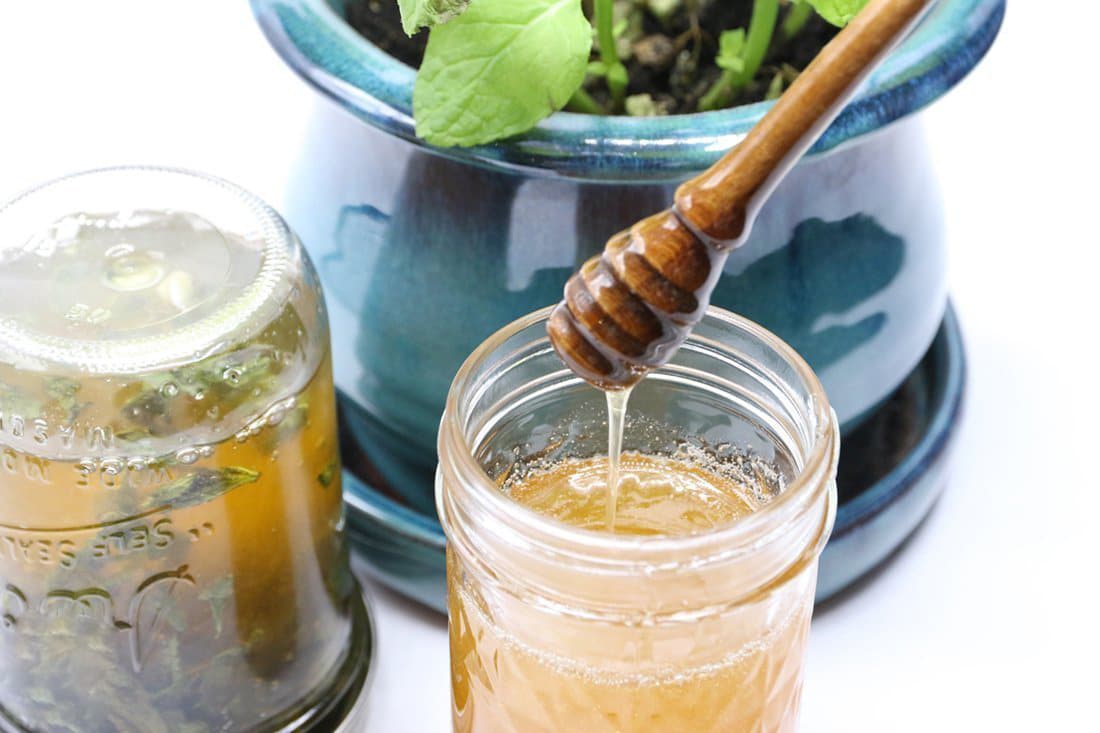There’s nothing quite like fresh mint. I try to keep at least one peppermint plant going in my kitchen herb garden, and have incorporated it on a larger scale in my outdoor herb/medicine garden. It’s chock full of benefits all by itself, but paired with raw honey it becomes a therapeutic (and delicious) powerhouse! ♥
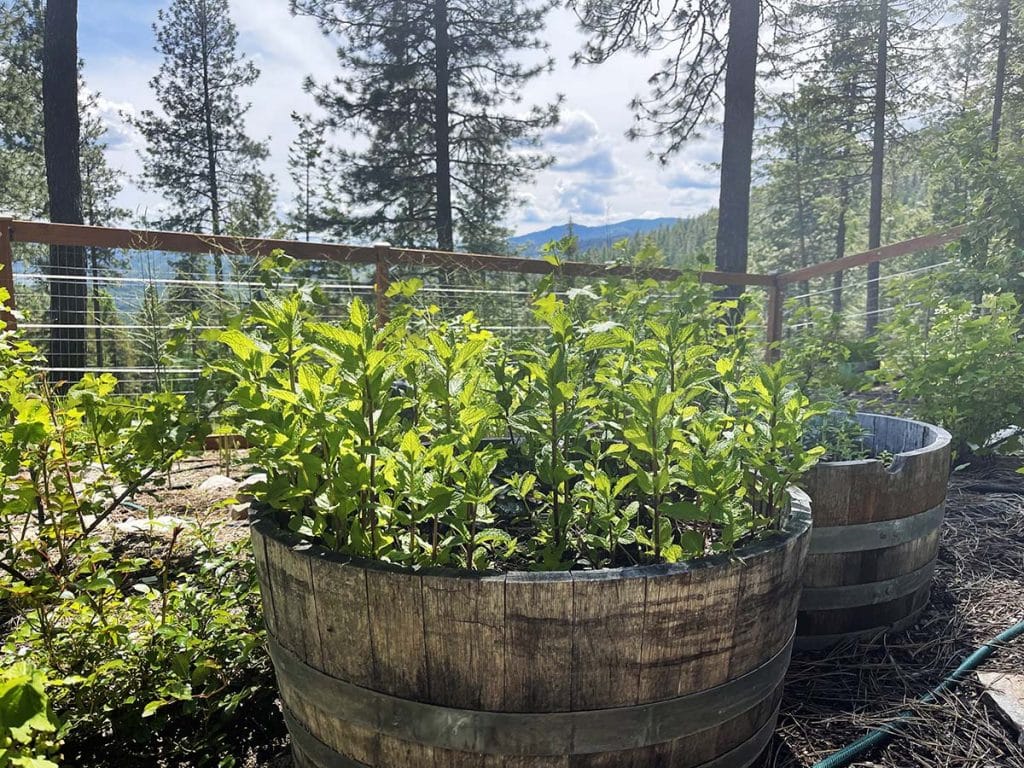
Peppermint-y
Peppermint (Mentha piperita) is a member of the Lamiaceae family that also includes basil, lavender, lemon balm, oregano, sage, rosemary and thyme.
(admit it, you sang the last three 🎶)
It’s probably best known as a breath freshener and a remedy for upset stomach or nausea associated with morning sickness. But that’s really just scraping the surface… peppermint is good for so much more.
It’s a tantalizing paradox of cooling yet warming, sweet yet pungent, relaxing yet stimulating energetics. Its latin name, mente, literally means “thought,” indicating that the Romans considered it to be more than just a tasty addition to a salad — peppermint is brain food.
Peppermint contains a wide array of active constituents — primarily volatile oils (aka essential oils), flavonoids, tannins, phenolic acids and a slew of vitamins and minerals such as magnesium, phosphorus, calcium, iron, niacin, potassium, sodium, selenium, riboflavin, thiamine, niacin and vitamins A and C. (whew!)
Peppermint’s essential oil alone is made up of over 40 different compounds, including menthol, menthone, limonene and carvone — all of which contribute to its therapeutic effects.
- Menthol – This monoterpenoid is the most abundant compound in peppermint’s essential oil, constituting up to 50% of the oil. Menthol gives peppermint its cooling, refreshing sensation by triggering cold-sensitive receptors. It has analgesic, anticough and gastrointestinal effects.
- Menthone – Another monoterpenoid that makes up 10-30% of peppermint essential oil. Menthone has antispasmodic and antiviral properties. Together with menthol, it provides the characteristic minty aroma.
- Flavonoids – Peppermint is rich in flavonoids like eriocitrin, hesperidin and luteolin. These polyphenols have antioxidant, anti-inflammatory, and antimicrobial effects that support the immune system.
- Rosmarinic acid – This phenolic compound acts as a powerful antioxidant. It also has anti-inflammatory, antimicrobial and antiviral properties. Peppermint has one of the highest antioxidant capacities among herbs due to its high rosmarinic acid content!
- Triterpenes – Oleanolic acid and ursolic acid are triterpenoids in peppermint that contribute to its anti-inflammatory and anti-tumor capabilities.
- Trace amounts of other terpenoids, phenolic acids and amino acids in peppermint essential oil play synergistic roles in the plant’s therapeutic potential.
Topical uses
The essential oil of peppermint applied topically (always diluted of course) increases skin blood flow via vasodilation, stimulating circulation and creating a lovely cooling sensation and relieving pain by acting on cold-sensitive TRPM8 cold receptors in the skin and mucous membranes.
Peppermint’s powerful analgesic (pain-relieving) actions are useful for easing earaches, tooth and muscle aches. The high menthol content provides cooling pain relief by blocking pain perception on skin and mucous membranes, making it useful for relieving headaches when applied to the temples and forehead.
Menthol has shown promise in supporting skin barrier function in very small quantities. This is an interesting example of “the dose makes the poison” — in one study, topical menthol at 0.1% (approx. 0.2% peppermint oil) helps with skin barrier repair while menthol at 5% acts as a barrier disruptor.
Peppermint is also antimicrobial and are effective against a range of bacterial, viral and fungal infections.
Aromatherapy
In aromatherapy, the smell of peppermint is simultaneously calming and stimulating. The volatile oils in peppermint (including menthol), which are responsible for its minty scent and taste, are useful in relieving anxiety and tension and also for refreshing and energizing the senses.
I’m a longtime fan of Dr. Bronner’s peppermint Castile soap for this very reason… the invigorating smell and cooling effects of peppermint soap is a beloved part of my wakeup ritual. ♥
Inhaled peppermint may even be protective against seasonal allergies, showing some antiallergenic potential in studies on mice.
Internal uses
As a digestive aid, the bitters in peppermint tone and cleanse the liver, and also stimulate the bile and digestive juices necessary to jumpstart the digestive process. Peppermint’s menthol content is responsible for its ability to relax gastrointestinal smooth muscle, while its antispasmodic and carminative actions can ease cramping of the stomach associated with gas and digestive upset. Peppermint has been called the “drug of first choice” for IBS sufferers.
Peppermint can provide relief from nasal congestion and its anti-inflammatory and histamine inhibiting flavonoids have been shown to be an effective treatment for allergic rhinitis (hay fever) and other respiratory ailments. Menthol’s antitussive (cough suppressing) and expectorant actions are a match made in heaven paired with honey, which has been shown to be just as effective as common, over-the-counter cough suppressants containing dextromethorphan (DM).
Sweet sweet (raw) honey
Raw, unpasteurized, unfiltered honey has a long history in folk medicine as a cough suppressant and a soothing remedy for sore throats. It’s anti-inflammatory and antibacterial properties make it beneficial for everything from asthma to UTIs to ulcers.
Honey’s antibacterial and anti-inflammatory properties can help soothe sore throats from colds or allergies. Taking a spoonful of raw honey can coat and heal an irritated throat. Adding it to tea is another option.
Raw honey contains enzymes like amylase, lipase and protease that may aid digestion. Its antioxidant and antimicrobial effects support a healthy gut. Some find regular honey consumption helps reduce symptoms of acid reflux.
Honey is also a source of prebiotic fructooligosaccharides, which nourish intestinal gut bacteria critical for digestion and health in general.
If you opt for a local variety and consume it regularly, it may also protect against environmental allergies such as those caused by seasonal pollen. Consuming local honey introduces small amounts of allergen pollens and desensitizing the immune system to the allergens that would normally trigger a reaction.
Topically, honey’s antimicrobial properties make it useful for treating minor wounds, burns and skin infections. Honey’s viscosity provides a protective moist wound healing environment that promotes new tissue growth and rapid healing with minimal scarring. Its acidic pH (between 3 and 4.5) restores skin’s naturally acidic barrier and prevents microbe growth. Honey’s glucose oxidase enzyme also produces small amounts of hydrogen peroxide, which gives it disinfectant properties.
These protective and antiseptic/antimicrobial properties combined with honey’s anti-inflammatory actions make honey a natural choice for conditions like acne, eczema, psoriasis and dandruff.
In skincare applications, honey is an extremely nourishing humectant, meaning it draws moisture into the skin and helps to keep it hydrated. Additionally, honey’s mildly astringent actions tone, tighten and stimulate circulation in the skin, creating a healthy glow and a tightening effect.
Honey may actually improve the delivery of nutrients into the skin. Studies show that combining honey with aqueous solutions of nutrients like vitamin C and E leads to enhanced absorption and bioavailability within the skin’s epidermal and dermal layers. The glucose and fructose sugars may facilitate the passing of antioxidants through the lipid layers of the skin.
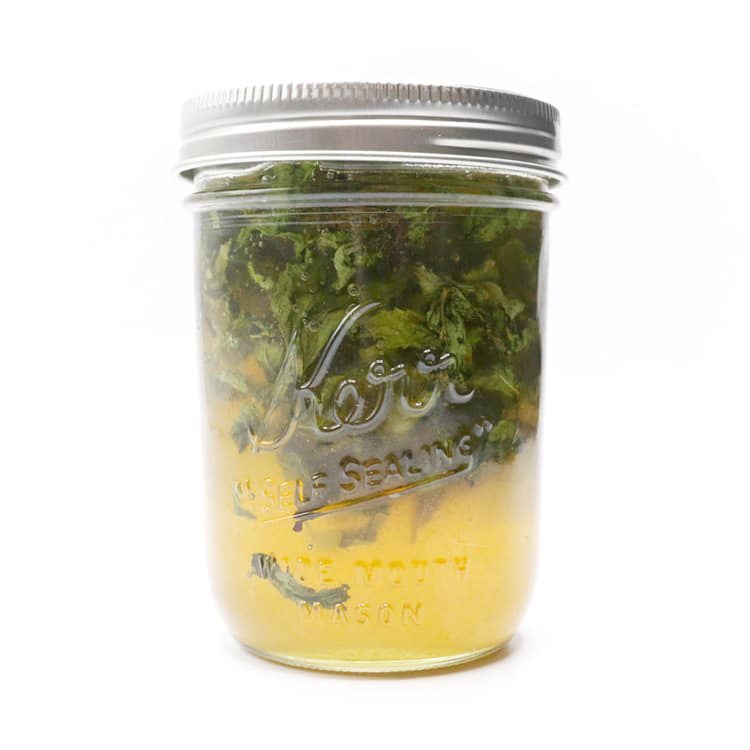
Please note that we’re talking about raw, unpasteurized, unfiltered honey here… commercial pasteurized honey is not the same thing. The heat of pasteurization kills off the beneficial enzymes and damages many of the vitamins and antioxidants that make honey so nourishing. The ultrafiltration process that makes commercial honey look pretty on the shelf also strips away nutritious pollen that contains many of honey’s vitamins, amino acids, essential fatty acids, micronutrients and antioxidants.
It’s well worth the effort to locate a local source of raw honey in your area. If you have a farmer’s market nearby, that’s a great place to start. Or try searching online for your town/city/zip code + “raw honey,” and see what the search engine delivers. I’ve also used localharvest.org and organicnearby.com as online resources for finding farms, CSAs and farmer’s markets in my area. As a fun bonus, Local Harvest also keeps tabs on local food-related events going on in my area, such as festivals, volunteer opportunities and gardening classes! Woot!
Peppermint honey in all the things
Mr. Redheaded Herbalist disagrees, but I think mint and coffee are a match made in heaven. I “peppermint” my coffee often, (not just at the holidays!) and if you like a bit of sweet in your java, this infused honey is a perfect way to do that.
It’s also a lovely addition to iced and herbal teas. Or anything, really… You do you!
Virgin mojito with mint + ginger
We also enjoy making virgin mojitos (faux-jitos?) using a simple syrup made from this mint-infused honey. Now I’m not one to shy away from the occasional adult beverage, but in this case, we actually enjoy the mocktail more than the cocktail with the added rum! Go figure.
To make the simple syrup, make a ginger tea by steeping a thumb-sized piece of finely chopped ginger in 1 cup of hot water. Allow time to cool. Strain out the ginger (or don’t if you like a stronger ginger flavor) and add 1 cup of your mint infused honey, stirring to blend. Store in the refrigerator until ready to use, up to a month.
For convenience, I sometimes use The Ginger People ginger juice instead of the root, but you really can’t beat the flavor of a piece of fresh ginger. If using the juice, leave the ginger root out of the simple syrup recipe, and just add 1/2 tsp ginger juice per mojito.
- 1 T fresh lime juice
- 1 T mint-honey simple syrup with ginger
- 6 oz sparkling mineral water
In a glass over ice, add mint-honey simple syrup, lime juice, ginger and top with the sparkling mineral water. Garnish with a wedge of lime and additional fresh mint leaves.
Excuse me a moment…
*runs off to whip up a faux-jito*
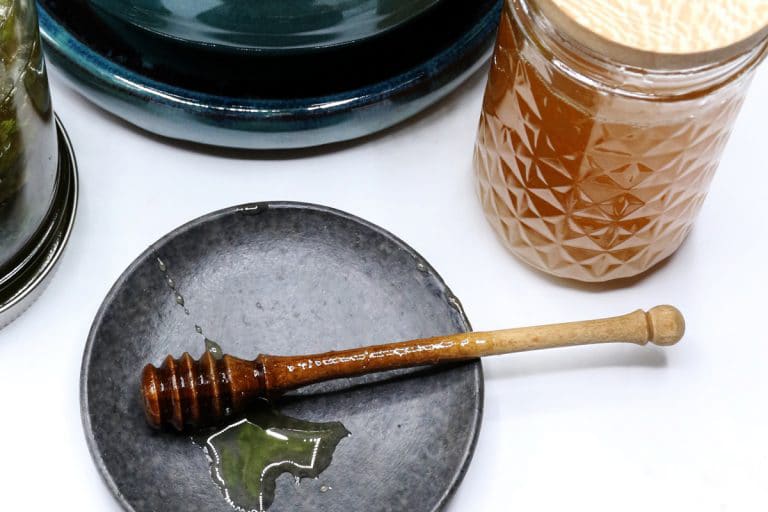
You can use this basic infused honey method for any number of herbs.
What kind of infused honey will you make?
Hopefully you’re inspired to experiment with a favorite herb or two, or maybe try something new! I make a wonderful jalapeño-infused honey for a copycat cocktail recipe I make (will post about this soon!) Lemon or wild cherry bark-infused honey is soothing on a sore throat and makes a killer cough suppressant. Elderberry and elderflower infused honeys also have incredible immune boosting benefits.
Cinnamon honey? Yum!
Lavender honey?
Hibiscus?
Rose hip?
Oh, the possibilities! ♥
P.S. For more information about making infusions like this one, I highly recommend Rosemary Gladstar’s Medicinal Herbs, A Beginner’s Guide. She covers the basics of growing your own herbs, making medicinal infusions, syrups, decoctions, tinctures, etc. and the last half of the book is organized like an encyclopedia of useful herbs — what they are and what to do with them, complete with beautiful, full-color photos and recipes. Good stuff!

Mint-Infused Honey
5 Stars 4 Stars 3 Stars 2 Stars 1 Star
No reviews
Ingredients
enough fresh mint leaves to loosely fill a pint sized mason jar
raw, unfiltered honey (preferably local)
Instructions
- Wash your fresh mint leaves and spread them out on paper towels or a wire cooling rack. Allow to dry and wilt overnight to eliminate excess moisture that can lead to mold growth.
- Add mint to a clean mason jar and cover with honey until jar is full and the leaves are fully submerged. If honey is too solid to pour, gently heat it by placing it in a warm water bath. Take care not to heat the honey beyond about 110F, or you risk destroying its beneficial enzymes.
- Secure the jar’s lid, and place in a sunny windowsill.
- Flip the jar onto its lid once a day or so. This ensures that the mint is staying submerged under the honey. You do not want the mint exposed to any oxygen or you risk contamination and bacteria growth.
- Infuse for 2-4 weeks, allowing plenty of time for the herb’s medicinal properties and flavor to extract into the honey.
- Strain out the herbs using a fine mesh strainer, making sure there is no remaining plant matter in your infusion. Gentle heat (again, keep it below 110F) will help thin the honey sufficiently to strain easily. ♥
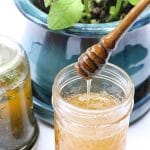
Faux-jito
5 Stars 4 Stars 3 Stars 2 Stars 1 Star
No reviews
Ingredients
simple syrup
2” piece of ginger root, finely chopped
1 c hot water, just off the boil
1 c mint-infused honey (recipe above)
virgin mojito
1 T fresh lime juice
1 T mint-ginger simple syrup
6 oz sparkling mineral water
Instructions
- To make the simple syrup, make a ginger tea by steeping a thumb-sized piece of chopped ginger in 1 cup of heated water, just off the boil.
- Allow time to cool, then strain out the ginger.
- Combine ginger tea with 1 cup of your mint-infused honey, stirring to blend.
- In a glass over ice, add mint-ginger simple syrup, lime juice and top with the sparkling mineral water. Give it a quick stir to blend.
- Garnish with a wedge of lime and additional fresh mint leaves.
- Cheers! ♥
Notes
Mint-ginger simple syrup should keep in the refrigerator for up to 1 month.
